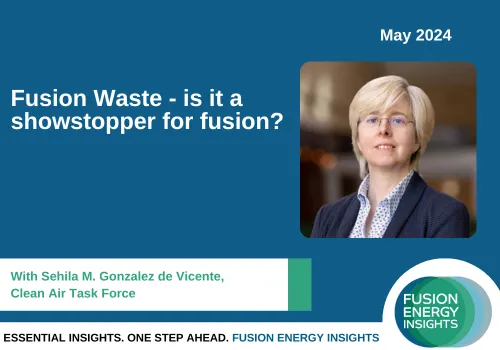3 Key Insights - Fusion Waste: Is it a Showstopper for Fusion?
In our third member Q&A session of 2024 on the 22nd May, we discussed waste generation from fusion. Our expert speaker was Sehila M. Gonzalez de Vicente, Global Director of Fusion Energy at the Clean Air Task Force.
Sehila spoke about the typical wastes generated from fusion activities and the importance of funding research and development into radiological waste management to further minimise and optimise the waste footprint of fusion.

Here are three key insights from the event.
1. The generation of radiological waste from fusion activities is not a showstopper for fusion development, but we need to implement radioactive waste considerations from the outset of fusion power plant planning.
Fusion will generate radiological waste. That is a known fact. Other industries, for example the medical and pharmaceutical industries, also generate radioactive waste.
If good radiological waste management practices are implemented from the beginning of the design of fusion devices then the production of waste can be minimised.
There are two main sources of radioactive waste in fusion:
· Materials activated by the neutrons from the fusion reaction
· Materials which are contaminated by tritium.
Tritium is one of the major isotopes in the radioactive waste generated in fusion devices. Sehila identifies tritium as “one of the specificities of fusion waste.”
Fusion waste is different to the waste generated by nuclear fission. In nuclear fission the radiotoxicity of waste can last for thousands of years, whereas in fusion the radiotoxicity is not expected to last for more than a hundred years. Fusion waste will also not contain fission products or transuranium elements.
Sehila says in regards to waste generation from fusion: “we can improve. We should improve. We want fusion to be a clean source of energy, but there is nothing to stop fusion progress right now related to radioactive waste. The radioactive waste strategy should be implemented from the beginning as an iterative process during the design phase … We need to start with R&D [research and development] in that area. And honestly, I think this R&D should be driven by the public sector, because it will help everyone and, at the end of the day, the public sector is the one creating these repositories and issuing the regulations. So, it should be a strong push from the public sector – this is my opinion.”
Complicated trade-offs exist between economics, operation, design and waste production and management in fusion. Lower-cost materials with higher impurity levels may seem attractive with lower costs at the construction stage, but the impurities will lead to high neutron activation and either a large volume of lower activation waste or even higher-activation waste. This will lead to higher waste disposal costs and higher ultimate project costs in the long-term.
2. Fusion will produce waste like any other industry, including radioactive waste. Although the amount of radioactive waste may be significant, it may be entirely low- or very low-level waste, for which there are existing waste disposal pathways.
Sehila showed that fusion will produce a significant quantity of Low Level Waste (LLW). Low level waste is defined in the UK as containing “low levels of radioactivity, not exceeding 4 gigabecquerel (GBq) per tonne of alpha activity, or 12 GBq per tonne of beta/gamma activity” (UK Radioactive Waste Inventory).
The final amount of low level waste produced by different fusion projects will depend on the design of the machine. The low level waste volume may be significant, but the disposal procedures are already established so it should not pose a problem for fusion developers—but it is a cost, which must be factored into decision-making.
Other industries also produce low level radioactive waste, but also large volumes of other hazardous wastes, for example the oil and gas industries generate vast amounts of carbon dioxide emissions, a waste, which is having an impact on the global climate. Yet Sehila argues that much scrutiny is on the fusion industry and the wastes it will generate, but she argues that the fusion community should definitely try to minimise waste generation “for the public and for the impact on society”, but also insist that the disposal pathways for low level wastes “exist and they are under control. They have guarantees and it is safe.”
3. Radiological waste management is not uniform across the globe. We need harmonisation of waste criteria and the fusion community should push for this.
There are no globally harmonised criteria when defining types of waste or their disposal pathways and this means that there is huge variation across the world in approaches to radioactive waste. Sehila thinks that the fusion community should push for harmonisation of waste criteria.
Sehila says: “the national law component of waste means that every country and every member state has its own [waste] regulation and it varies from one to the other. And this can cause some inefficiencies.”
Sehila argues that the waste R&D that she calls for should also be directed towards pushing for common definitions of waste classifications between countries.
And finally…
Sehila closed the session by talking about public perception of waste and how to build trust amongst the public in the fusion industry.
Sehila argues that “the fusion community is guilty of previously selling the product of fusion as completely clean and we are not going to produce any waste and so on, which honestly is not true. Every single industry produces waste and that waste can be radioactive waste or regular waste, hazardous waste or not hazardous waste. But you have some waste. And again, what fusion needs to do is to educate people. We are like any other industry in the world, we will produce waste and within that waste we will have a portion that is radioactive waste and that portion of radioactive waste is comparable to the raw waste produced by other industries which are not fission.”
